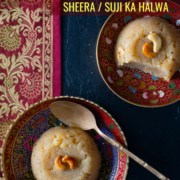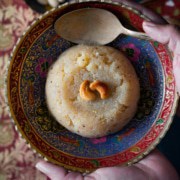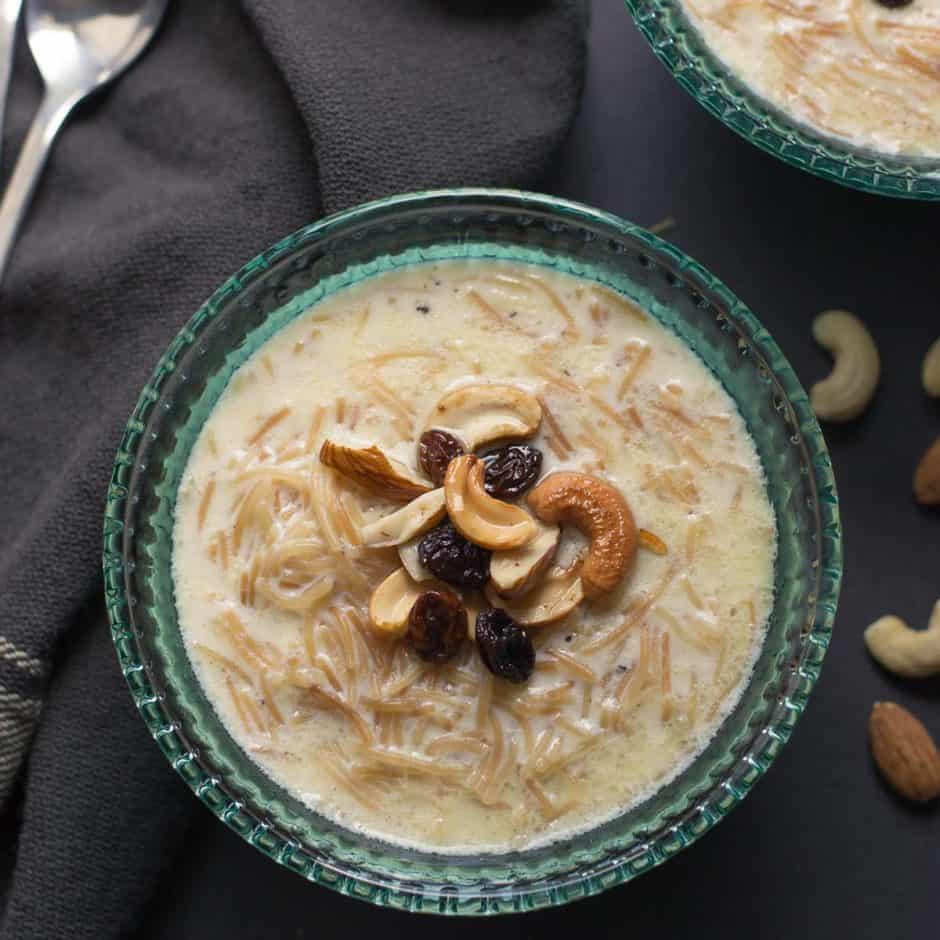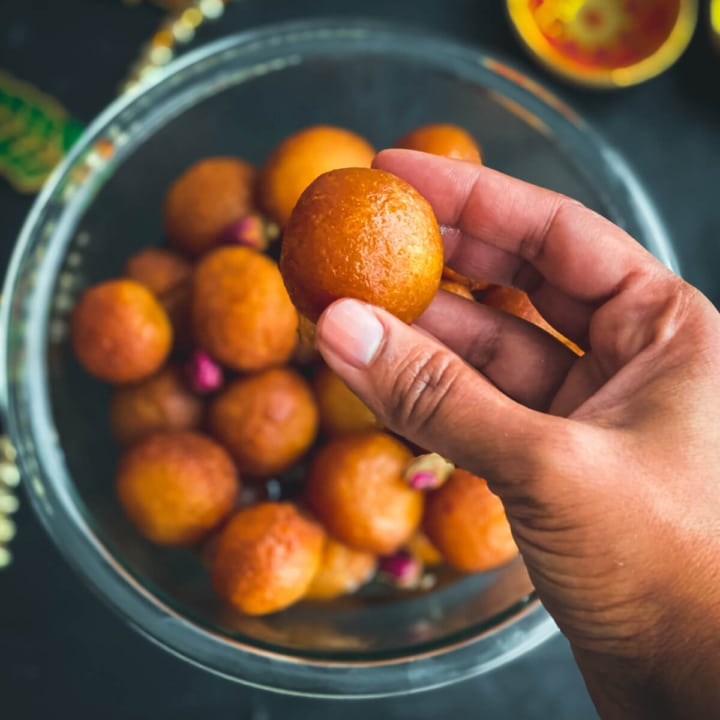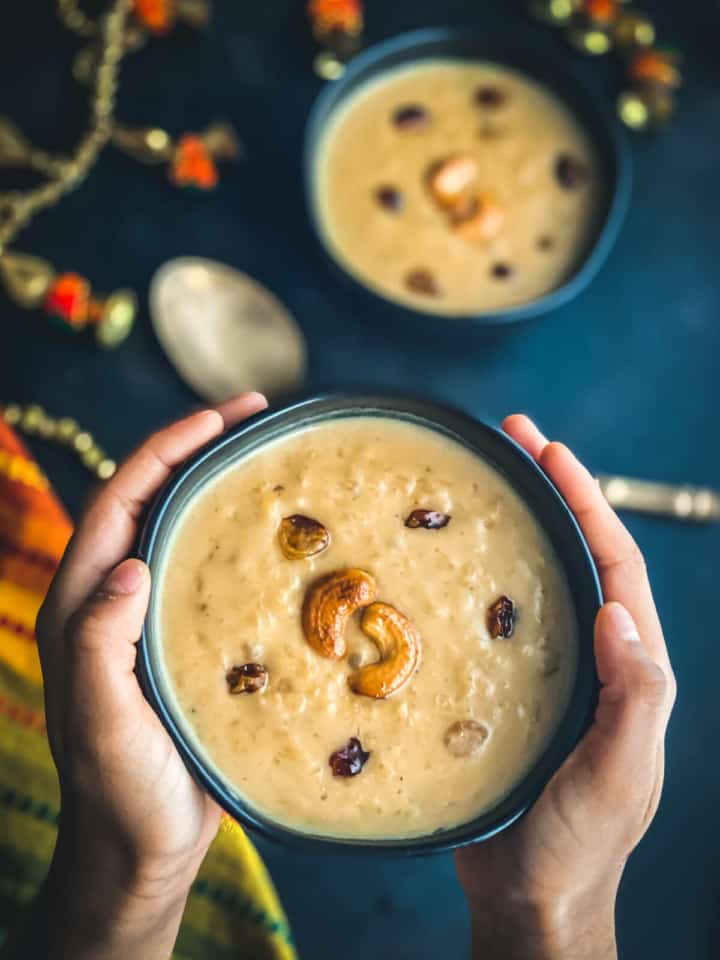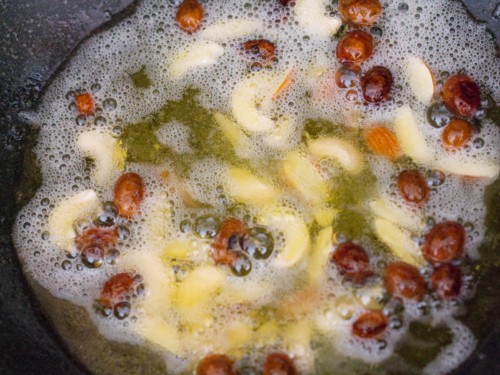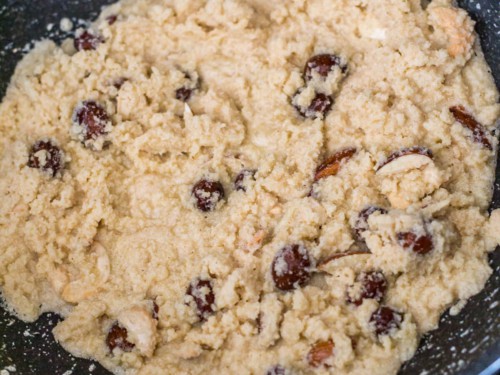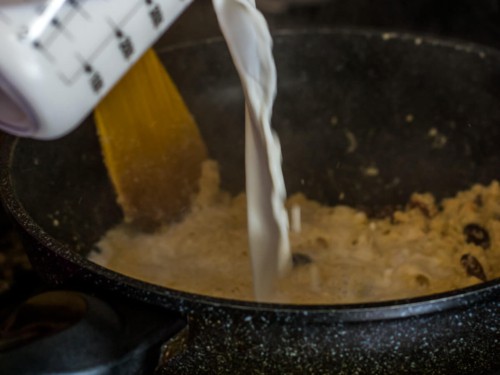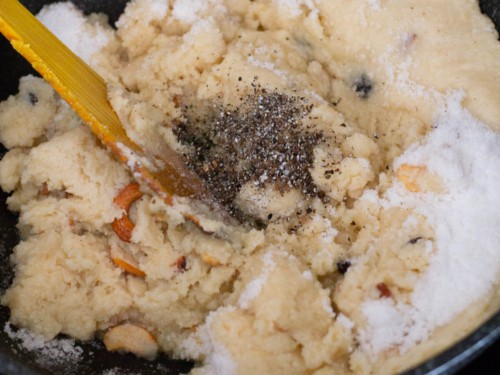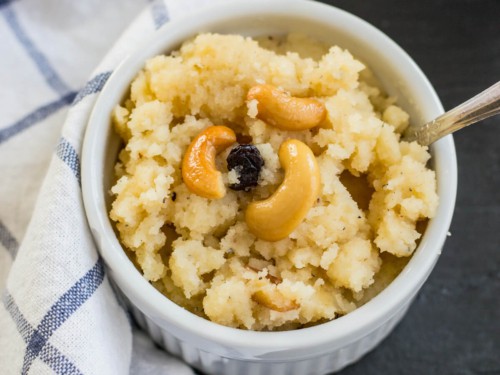Fail-proof Suji ka Halwa (Rava Sheera)
Note: This post contains affiliate links. As an Amazon Associate I earn from qualifying purchases.
Crumbly, sweet, and utterly delightful – that’s the essence of rava sheera, also known as suji ka halwa. Learn how to whip up this simple, traditional Indian dessert in under 30 minutes.
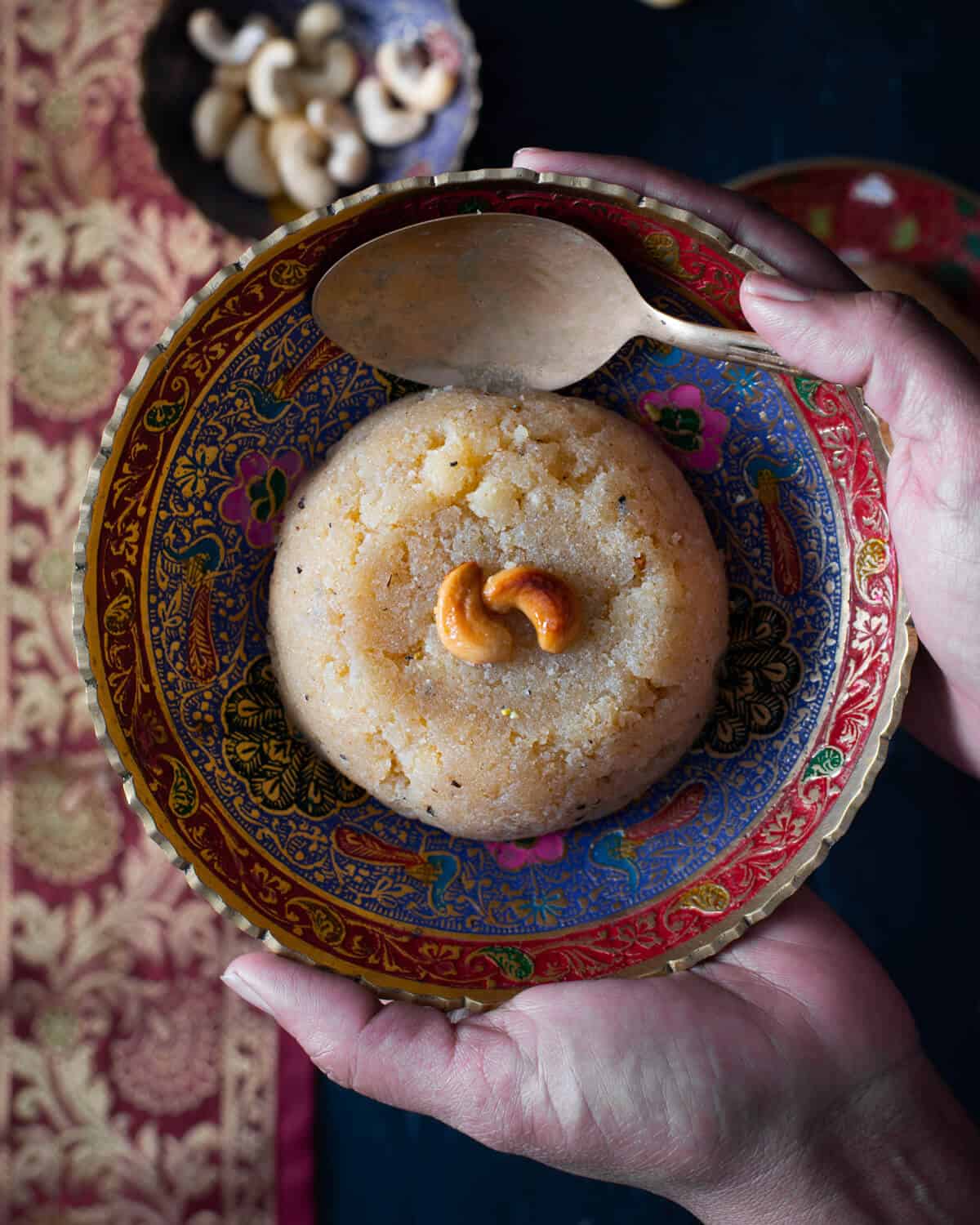
What is sheera or suji ka halwa?
In this Indian semolina pudding recipe, semolina is roasted in ghee and then mixed with milk (or water), your choice of nuts, sugar, and cardamom powder to create a deliciously crumbly, sweet dish.
Folks from Karnataka know it as sajjige, rava kesari, or kesari bhath. In north India, it is called suji ka halwa, whereas it is popularly known as sheera in Maharashtra.
In fact, every country seems to have its own version. It goes by semolina pudding in Europe and the US, whereas folks in the Middle East have their own variant called Lekhmat Al Helwa.
Often served as prasad (an offering to god) during festive occasions such as Ganesh Chaturthi, ashtami, and Satyanarayana poojas, sheera holds a very important place in Indian cuisine.
Before we get to this easy recipe, let’s address the million-dollar question here.
Is sheera good for you?
Before we answer the question, let’s have a little chat about semolina – the key ingredient in sheera.
What is semolina?
Semolina (rava / suji) is a coarse flour made from durum wheat and is usually golden or off-white in color. It is used for making a variety of dishes, including porridge, bread, and even pasta. It is a high-gluten product that is rich in vitamins, minerals, and carbohydrates.
Is semolina healthier than white flour?
Though both semolina and white flour are made from wheat, semolina is considered to be healthier than white flour.
White flour is bleached with a whitening agent, does not have fiber or protein content in it, and is rich in carbohydrates.
Semolina, on the other hand, is made from durum wheat and is a good source of vitamins E and B. It is slowly digested by the body, and hence, you feel satiated after eating semolina.
Is semolina better than whole wheat flour?
Semolina might seem similar to whole wheat flour, but they’re quite different. To grasp this distinction, it’s important to understand the wheat kernel’s structure.
A wheat kernel comprises three parts: the bran (outer skin, rich in fiber and antioxidants), the endosperm (the kernel’s largest portion, packed with starchy carbs and proteins), and the germ (the embryo, loaded with healthy fats, proteins, vitamins, and minerals).
Whole wheat flour (known as atta in Hindi) is derived from the entire wheat kernel, including the bran, germ, and endosperm. In contrast, semolina (or rava) is produced solely from the endosperm.
Since semolina loses fiber, vitamins, and minerals in the process of being made from durum wheat, manufacturers often fortify it, enhancing its fiber and protein content to create an enriched product.
That’s why, when compared to whole wheat flour, semolina is considered less healthy as the carbohydrate concentration in it is higher.
To wrap it up, semolina offers the following benefits (source – Semolina for weight loss).
- Boosts energy level as it contains carbohydrates.
- It is rich in iron and helps in improving blood circulation in the body.
- It contains calcium and is good for your bones.
- It is good for the nervous system because of magnesium, zinc, and phosphorous.
- Semolina has zero cholesterol.
So while semolina is great for you, sheera is not because of the amount of sugar that goes into the recipe. It is a great once-a-month indulgence, though, but if you want something healthy for your breakfast, this rava upma recipe made from semolina is a great choice.
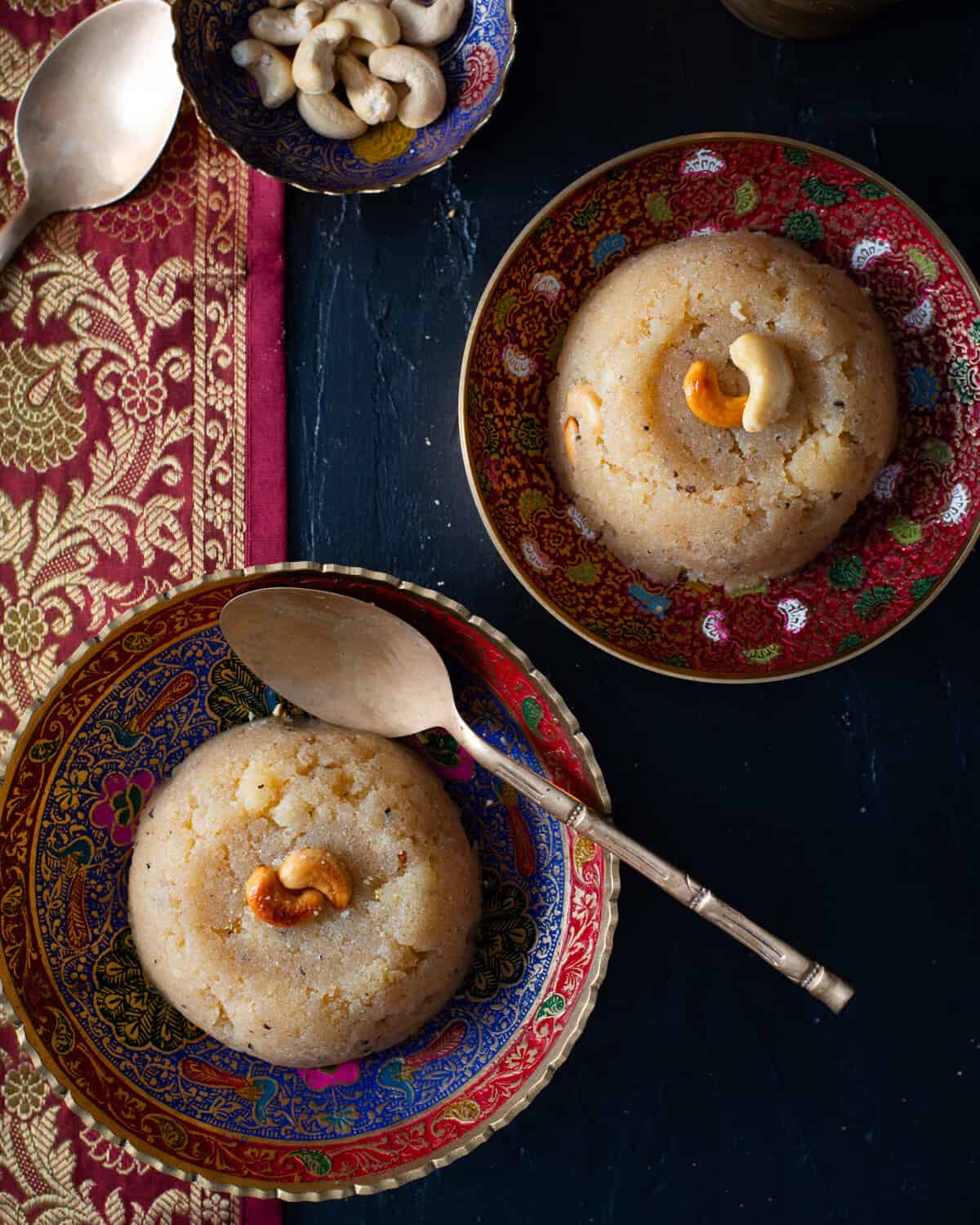
How do you make the perfect sheera?
Nailing the perfect sooji halwa recipe starts with selecting the right ingredients:
Ingredient notes/swaps
- Semolina (rava or sooji in Hindi): Opt for the fine variety of sooji for a soft, fluffy texture. Coarse Rava can also be used, though it results in a grainier texture.
- Ghee: You can use either store-bought or homemade ghee.
- Cashew nuts and raisins: These add a delightful crunch to the dish. You can also use finely chopped almonds as well.
- White sugar: Fine granulated sugar works best since it dissolves quickly.
- Liquid: You have the option of using whole milk or water, depending on your preference.
- Green cardamom, powdered: Use powdered cardamom to infuse the sheera with its characteristic aroma.
Be sure to check out the full recipe and ingredient list below.
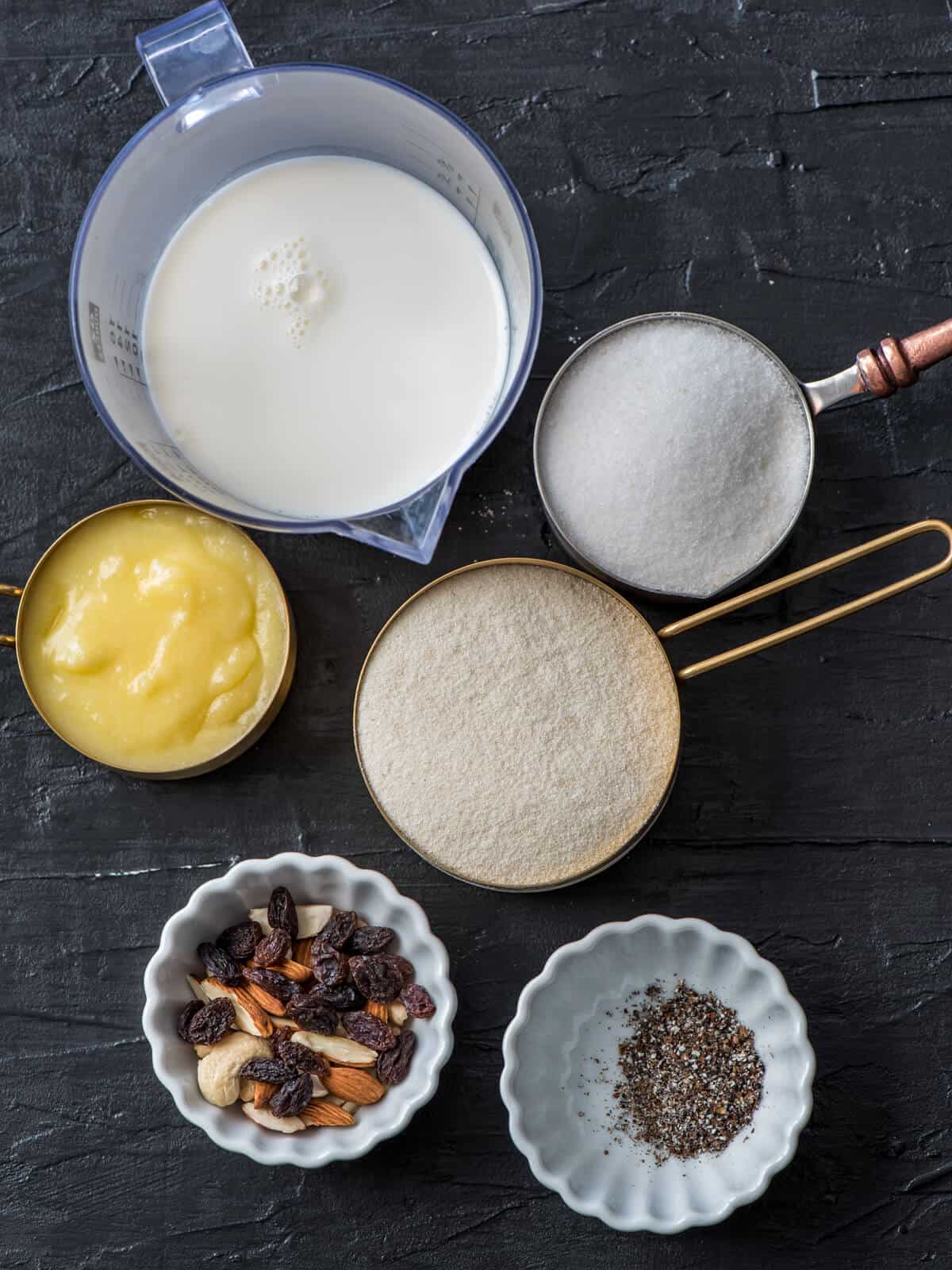
Many believe that making sooji halwa/sheera is quite simple, but my initial attempts were far from successful. My sheera often turned out clumpy, soggy, sticky, and greasy – a stark contrast to the finger-licking sheera served by my neighbor during kanya pooja.
Her sooji halwa was always a treat – perfectly sweet without being too much, with a non-greasy, crumbly texture that disintegrated at the slightest touch. Achieving that perfect and delicious sooji ka halwa became my goal, and I’m thrilled to have mastered a recipe that replicates it.
Here’s how you can do it too –
- In a saucepan, bring water or milk to a boil.
- Heat ghee in a wok or kadhai on medium heat.
- Fry cashews and raisins in ghee until they turn golden brown.
- Add sooji to the wok and roast for 10-12 minutes until it’s evenly brown and fragrant.
- Lower the heat to medium-low. Carefully pour the hot liquid into the sooji mixture, stirring continuously to prevent lumps.
- Let the halwa cook for a couple of minutes.
- When all the liquid has been absorbed, add sugar and cardamom to the halwa and continue cooking until the sugar is completely melted and absorbed. Once the halwa starts to leave the sides of the pan, turn off the heat.
- Serve the halwa hot.
Sheera ratio: The secret to perfect suji ka halwa lies in getting the proportions right. For every cup of semolina, use 3 cups of water or milk and 1 cup each of sugar and ghee.
Take a look at the detailed step-by-step pictures provided for making this delicious suja ka halwa, and be sure to follow the accompanying tips. This will help you create the perfect sheera we all love and crave.
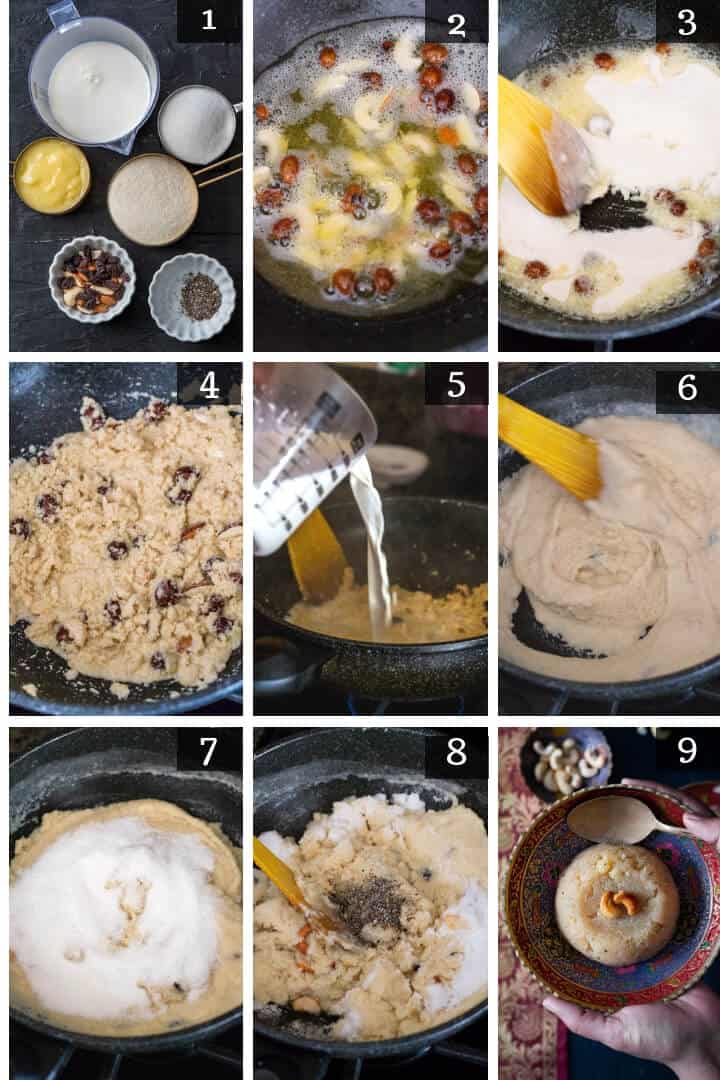
Tips for a perfect suji ka halwa recipe
- Follow the 1:1:1 ratio: Ideally, use equal amounts of semolina, sugar, and ghee for an authentic sheera recipe. However, slightly reducing sugar and ghee can still yield similar results. For instance, I typically use 3/4 cup of sugar and ghee for 1 cup of semolina.
- Roast semolina to golden brown: Roasting semolina in ghee over a slow flame for 10-12 minutes is crucial. This step prevents sticking and eliminates the raw taste. If using nuts, sauté them in ghee first, then add semolina.
- Reduce heat when adding hot water or milk: Lower the heat before adding hot liquid to semolina to prevent splattering.
- Stir immediately & constantly after adding liquid: Continuous stirring right after adding the liquid helps avoid lumps.
- Measure ingredients if you’re a beginner: If new to making sheera, accurately measure ingredients. Getting the right proportions is very important.
- Balance the liquid content: Too little liquid leads to dry sheera, while too much makes it soggy and clumpy.
- Don’t skimp on ghee: Ghee not only adds flavor but also prevents the semolina from clumping together.
Storage instructions
Store any leftover sheera in the refrigerator for about 5-6 days. Heat before serving.
Variations
Now, there are a few variations to this suji halwa recipe that you can try.
- Fruit-infused sheera: Add finely chopped pineapple or elaichi kela (banana) for a unique and delicious twist.
- Saffron sheera:
- Soak a pinch of saffron in warm water for 10 minutes.
- Mix the saffron-infused water with boiled water or milk.
- Add this mixture to roasted semolina for a beautiful yellow color.
- Rava kesari: Add a few drops of artificial orange coloring while adding the liquid to achieve a vibrant orange hue.
- Using sugar syrup:
- Dissolve sugar in boiling water, then add this syrup to the sheera.
- For a healthier option, use jaggery instead of sugar (filter if necessary for impurities).
- Half milk/Half water: Use either all milk or a combination of half milk and half water for the liquid component.
Serving suggestions
Sheera is commonly enjoyed for breakfast, as a dessert for special occasions, or as an evening snack. To make prasad for ashtami, pair it with pooris and kala chana.
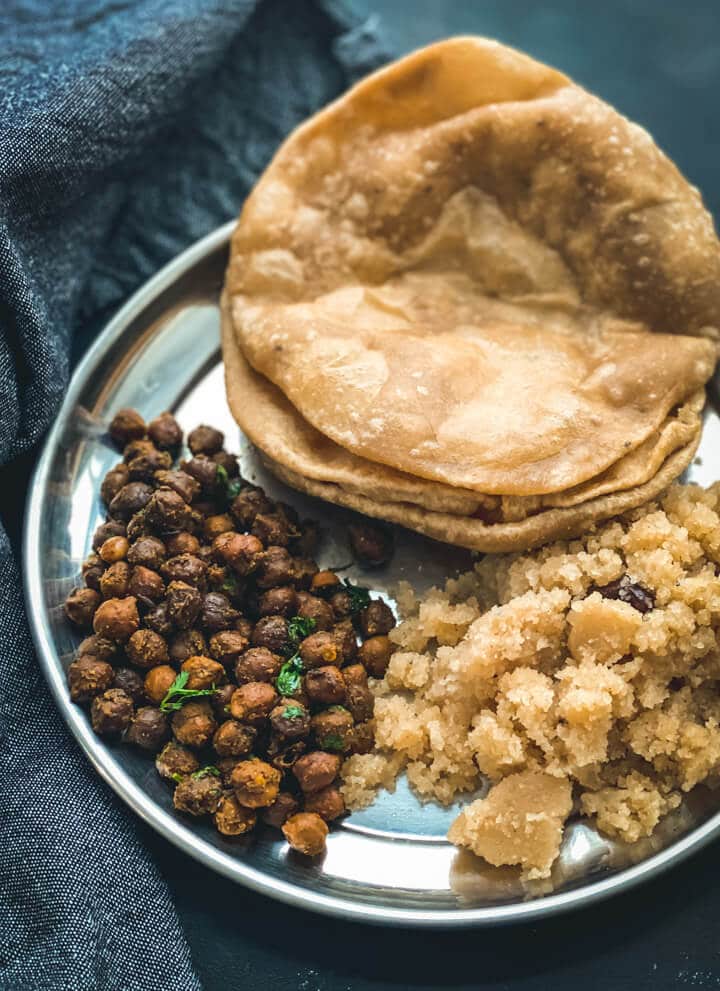
Other delicious Indian dessert recipes to enjoy
Savor the sweetness of Gajar Halwa, a beloved Indian dessert crafted from grated carrots, milk, and sugar, using this almost hands-free Instant Pot method.
Whip up this creamy and delicious dessert in no time. It’s the perfect quick fix for your sweet tooth!
Experience the joy of India’s most cherished dessert. A buffet favorite, now easily made at home!
Celebrate festivities with Moong Dal Payasam, a staple in Mangalorean homes. Learn to create this traditional dessert in half the usual time, without compromising on the taste.
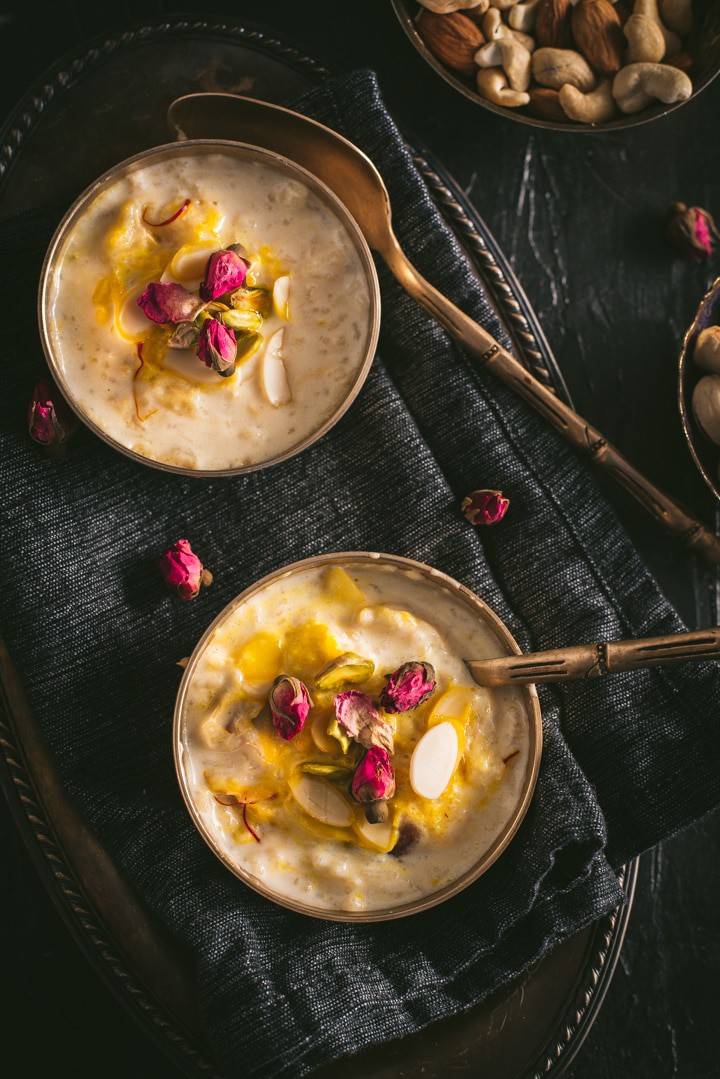
Discover the convenience of making creamy, flavorful Rice Kheer in an Instant Pot. This Indian rice pudding comes out creamy and flavorful without spending hours in the kitchen.
Need more dessert recipes? Check out this list of 45+ easy Indian desserts and sweet recipes for when you need fresh ideas to wow your family and friends.
Try our fail-proof sooji halwa recipe for a comforting, sweet treat that’s perfect for any occasion. Easy to follow and full of flavor, this classic dessert is sure to please everyone!
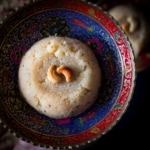
Sheera / Suji Halwa (Semolina Pudding)
Ingredients
- ¾ cup ghee
- ¼ cup dry fruits halved cashews, almonds, raisins
- 1 cup fine semolina suji
- 3 cups milk or water
- 1 cup sugar
- ¼ teaspoon cardamom seeds ground
Instructions
- In a saucepan, add water or milk and let it come to a boil.
- In a wok or kadhai, add ghee over medium heat and once it is hot, fry the cashews and raisins till they are golden brown.

- Add sooji to the wok and roast it for about 10-12 minutes till it is evenly brown and fragrant.

- Lower the heat to medium-low. Carefully pour the water or milk into the sooji mixture and stir continuously so that no lumps form. Let the halwa cook for a couple of minutes till all the moisture is absorbed.

- When all the liquid has been absorbed, add sugar and cardamom to the halwa and continue cooking until the sugar is completely melted and absorbed. Once the halwa starts to leave the sides of the pan, turn off the heat.

- For the best taste, enjoy the halwa piping hot.

Notes
-
- Follow the 1:1:1 ratio: Ideally, use equal amounts of semolina, sugar, and ghee for an authentic sheera recipe. However, slightly reducing sugar and ghee can still yield similar results. For instance, I usually use 3/4 cup of sugar and ghee for 1 cup of semolina.
-
- Roast semolina to golden brown: Roasting semolina in ghee over a slow flame for 10-12 minutes is crucial. This step prevents sticking and eliminates the raw taste. If using nuts, sauté them in ghee first, then add semolina.
-
- Reduce heat when adding hot water or milk: Lower the heat before adding hot liquid to semolina to prevent splattering.
-
- Stir immediately & constantly after adding liquid: Continuous stirring right after adding the liquid helps avoid lumps.
-
- Measure ingredients if you’re a beginner: If new to making sheera, accurately measure ingredients. Getting the right proportions is very important.
-
- Balance the liquid content: Too little liquid leads to dry sheera, while too much makes it soggy and clumpy.
-
- Don’t skimp on ghee: Ghee not only adds flavor but also prevents the semolina from clumping together.
Storage instructions
Store any leftover sheera in the refrigerator for about 5-6 days. Heat before serving.Disclaimer: Approximate nutritional information is provided as a courtesy and can vary depending on the exact ingredients/brands used. If you have health issues, please work with a registered dietician or nutritionist.
Nutrition
This recipe was first published on Oct 16, 2018, and has been updated with text and instructions on Dec 4, 2023.

